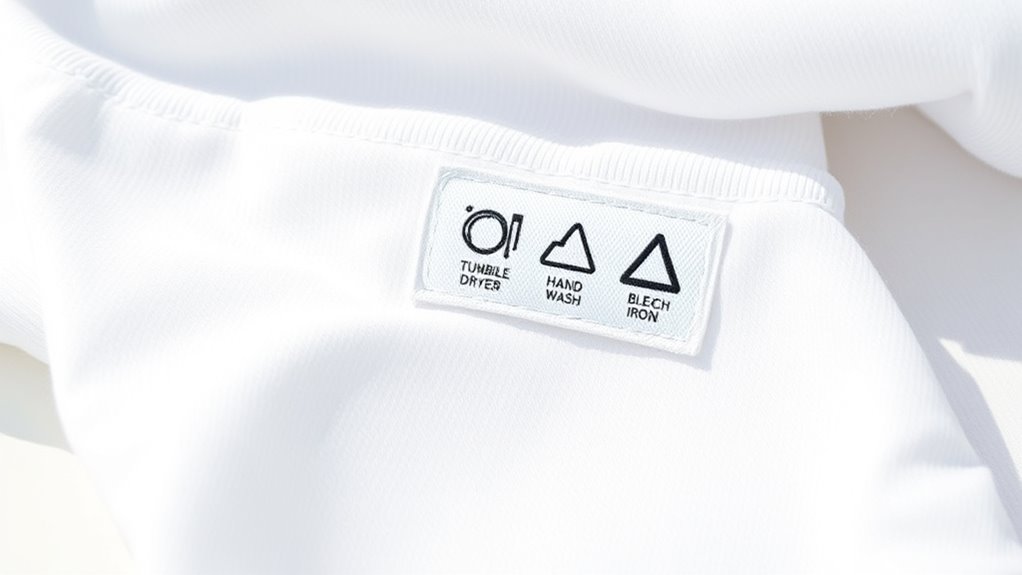Care label wash symbols give you quick, clear guidance on how to care for your clothes. You’ll learn which items need hand washing, gentle cycles, or shouldn’t be tumble dried at all. Recognizing these symbols helps prevent damage like shrinking or fading, saving you money and effort. Even if symbols seem confusing at first, understanding their true meaning is easier than you think. Keep going, and you’ll discover simple tips to keep your wardrobe in top shape.
Key Takeaways
- Recognize symbols indicating whether to hand wash, machine wash, or avoid washing altogether.
- Understand drying symbols, including tumble drying, line drying, and restrictions.
- Decode temperature settings using dots inside drying or washing symbols for proper care.
- Use labels correctly to prevent damage like shrinking, fading, or fabric warping.
- Applying these symbols ensures clothing longevity, saves energy, and maintains appearance.

Care labels might seem confusing at first, but understanding what they say can help you take better care of your clothes and extend their lifespan. One of the most important parts of these labels is the fabric symbols, which provide visual cues about how to handle your garments properly. These symbols are designed to be universal, so whether you’re shopping in New York or New Delhi, they tell you the same thing. For example, a tub with a hand inside indicates hand washing is recommended, while a tub with a line underneath suggests machine wash on a gentle cycle. Recognizing these fabric symbols helps you avoid damage caused by improper washing, drying, or ironing.
Understanding care label symbols helps protect your clothes and extend their lifespan.
Drying instructions are another critical element of care labels. You’ll notice symbols like a square with a circle inside, which signals tumble drying. A dot inside the circle indicates a low heat setting, two dots mean medium heat, and three dots signify high heat. If the symbol has a cross over it, it means you should avoid tumble drying altogether. Knowing what these drying instructions mean can prevent shrinking, warping, or fading. It’s tempting to just toss laundry into the dryer, but understanding these symbols guides you to choose the safest drying method for each item. For delicate fabrics like silk or wool, line drying or laying flat might be recommended instead, especially if the label shows a square with a horizontal line inside.
The fabric symbols and drying instructions serve as a quick reference, saving you from guesswork and potential damage. By paying attention to these symbols, you can decide whether an item needs a gentle wash cycle, should be air-dried, or requires special handling like dry cleaning. They also help you conserve energy and extend the life of your clothes, which is better for your wardrobe and the environment. Many care labels include multiple symbols, so it’s worth taking a moment to decode each one before proceeding. This simple step ensures your clothes stay in top shape longer, maintaining their fit, color, and fabric integrity. Additionally, understanding different washing and drying symbols can guide you in selecting appropriate clothing care methods and avoid costly mistakes.
In short, understanding fabric symbols and drying instructions on care labels is a small effort that makes a big difference. It empowers you to care for your clothes correctly and avoid costly mistakes. Next time you do laundry, take a second to glance at those symbols—you’ll thank yourself when your favorite shirt stays vibrant and well-shaped for years to come.
Frequently Asked Questions
How Can I Identify Counterfeit or Misleading Care Labels?
You can identify counterfeit or misleading care labels by checking label authenticity through clear, accurate symbols and instructions. Genuine labels usually have consistent fonts, high-quality printing, and proper placement. Look for obvious errors, smudges, or missing symbols, as these are signs of counterfeit detection issues. Trust reputable brands and retailers, and compare labels with official manufacturer information online to guarantee you’re not misled by fake or confusing care instructions.
Are There Eco-Friendly Laundry Symbols I Should Look For?
You might notice some eco-friendly labels amid your laundry routine, signaling sustainable symbols that prioritize environmental impact. These eco-friendly labels often feature icons like leaves or water droplets, indicating eco-conscious practices like cold washes or biodegradable detergents. Keep an eye out for sustainable symbols that encourage energy and water savings, making your laundry more eco-friendly. Recognizing these symbols helps you make greener choices effortlessly, aligning your habits with environmental responsibility.
What Do I Do if the Label Is Missing or Torn?
If the label is missing or torn, don’t worry—you can rely on fabric care alternatives and DIY cleaning tips. Test a small, hidden area with water and mild detergent to see how the fabric reacts, then opt for gentle washing or spot cleaning. When in doubt, stick to cold water and air drying to prevent damage. These steps help you care for your clothes without specific wash symbols.
How Often Should I Check Care Labels for Updates?
Imagine your laundry routine as a dance, where each step depends on the rhythm of label updates. You should check care labels every few months, especially when switching detergents or fabrics. This keeps your laundry practices in sync with new instructions, preventing mishaps. Staying attentive to label updates guarantees you treat your clothes right, prolonging their life and maintaining their appearance. Think of it as tuning your dance for a flawless performance every time.
Can I Safely Ignore Care Labels on Vintage or Handmade Garments?
You shouldn’t ignore care labels on vintage or handmade garments, as label authenticity helps guarantee proper vintage care. These labels often contain essential washing instructions tailored to the fabric, preventing damage. Even if the label looks old or incomplete, follow general vintage care tips like hand washing or air drying. Ignoring the label can risk shrinking or ruining the piece, so always prioritize understanding its authenticity and proper vintage care guidelines.
Conclusion
Knowing how to decode care labels can extend your clothes’ lifespan and save you money. Did you know that improper washing can damage fabrics and reduce their lifespan by up to 50%? By understanding those symbols, you guarantee your garments stay looking their best longer. So next time you see a care label, you’ll confidently follow the instructions and keep your wardrobe in top shape. It’s a small step with big benefits for your clothes and your wallet.










